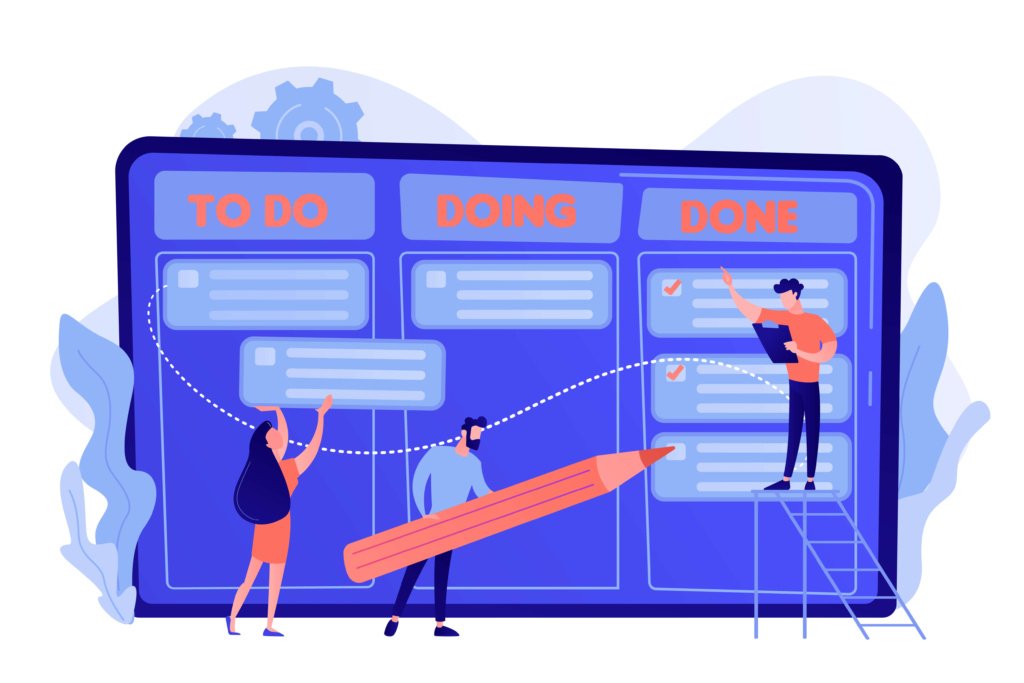Project Management
Jun 18, 2024
By
Sam
In non-IT projects, success might be measured by a completed building that meets safety standards, a marketing campaign that generates brand awareness, or a research project that leads to a ground-breaking discovery. By understanding these core principles and how they’re adapted to various industries, you can harness the power of project management to turn your ideas into reality.
You may like our blog on project implementation plan and implementing a plan.
Table of Contents
Communication and Collaboration – The Cornerstone of Project Success
Closure & Evaluation – Reflecting on Success and Learning from Experience
Summarization and Conclusion: Navigating Non-IT Projects
Identify Key Stakeholders
The initial step in any successful project is identifying all the key stakeholders involved. These individuals or groups can impact or are impacted by the project’s outcome. Building strong relationships and effectively communicating with them throughout the project lifecycle is crucial. Let’s explore the key actions for identifying stakeholders:

Define Roles and Responsibilities:
Pinpoint Individuals and Teams: Start by identifying all the individuals and teams involved in the project. This might include team members, managers, clients, sponsors, vendors, and even regulatory bodies (depending on the project type).
Outline Clear Expectations: Once you’ve identified your stakeholders, clearly define their roles and responsibilities. This involves outlining what each stakeholder is expected to contribute to the project and what level of decision-making authority they have. A clear understanding of roles avoids confusion and ensures everyone knows what’s expected of them.
Develop a RACI Matrix (Optional): For complex projects with numerous stakeholders, consider using a RACI Matrix. This matrix assigns Responsible, Accountable, consultant, and Informed roles (RACI) for each project task, clarifying decision-making hierarchies and communication channels.
Gather Stakeholder Input:
Understanding Needs and Expectations: Don’t just tell stakeholders about the project; involve them in the planning process. Gather their input on project goals, requirements, and potential challenges. This ensures the project aligns with their needs and expectations, increasing stakeholder buy-in and overall project success.
Conduct Interviews and Workshops: Consider conducting interviews or workshops with key stakeholders to gather their input. This allows for open discussions, brainstorming ideas, and identifying potential concerns early on.
Utilize Surveys and Online Tools: For larger projects, surveys, and online collaboration tools can effectively gather input from various stakeholders.
Maintain a Stakeholder Communication Plan:
Define Communication Channels and Frequency: Develop a stakeholder communication plan that outlines preferred communication channels (email, meetings, project management software) and the frequency of communication. This ensures everyone receives timely and relevant information about the project.
Tailor Communication Styles: Recognize that stakeholders may have different communication preferences. Some prefer detailed reports, while others prefer concise updates. Tailoring your communication style to each stakeholder ensures they receive the information they need in a way that resonates with them.
Proactive and Transparent Communication: Strive for proactive and transparent communication with stakeholders. Don’t wait for bad news to surface; keep stakeholders informed of successes and challenges. This fosters trust and strengthens relationships throughout the project.
Establish Project Scope, Timeline, and Budget
Following identifying key stakeholders, the next crucial step is establishing a clear and realistic project scope, timeline, and budget. This serves as the roadmap for your project, defining its boundaries, the timeframes for completion, and the financial resources required to bring it to life. You can lay the foundation for a successful project journey by meticulously considering the following points.

Break down the project into manageable phases
Identify Deliverables for Each Phase: Divide the project into distinct phases, each with well-defined deliverables. These deliverables are the tangible outputs of each stage, acting as milestones that demonstrate progress. For example, in a website development project, phases might include design, development, testing, and launch.
Estimate Time and Resource Allocation: Once deliverables are identified, estimate the time and resources required to complete each phase. Consider the complexity of tasks, skills needed, and team member availability. This helps ensure each phase is achievable within the overall project timeframe.
Sequence Phases Logically: Organize the phases in a logical sequence that reflects the project's natural flow. This ensures that dependencies between tasks are considered, and each phase builds upon completing the previous one.
Set realistic deadlines
Consider Task Complexity: When setting deadlines, factor in the complexity of each task within the project. Complicated tasks will naturally require more time than simpler ones. A realistic assessment of task complexity helps set achievable deadlines for each phase.
Account for Resource Availability: Don’t overload team members with unrealistic workloads. When setting deadlines, consider the availability of resources (people, equipment, materials). This ensures tasks are completed efficiently and avoids overburdening the team.
Build in Buffer Time: Unexpected challenges are a reality in any project. Factor in buffer time—a contingency period—within your deadlines to account for these unforeseen circumstances. Buffer time allows the project to adapt and stay on track even when roadblocks arise.
Monitor and update the project plan as needed
Track progress Regularly: Continuously monitor progress against the established project plan. Track completed tasks, identify any delays, and analyze resource utilization. Regularly scheduled progress meetings are a valuable tool for monitoring.
Communicate and Adapt: If deviations from the plan arise, communicate these changes transparently to all stakeholders. Be prepared to adapt the plan as needed. This might involve adjusting deadlines, reallocating resources, or redefining the project scope if necessary.
Maintain Project Flexibility: The project plan is a guide, not a rigid structure. Maintain flexibility to accommodate unforeseen circumstances or changing priorities. By being adaptable, you ensure the project can adjust to challenges and ultimately achieve its goals.
Conduct Feasibility Study
The third step in implementing a well-defined plan involves conducting a thorough feasibility study. This critical analysis acts as a risk assessment for your project, identifying potential risks and challenges that could derail it. Proactively evaluating alternative solutions and developing a risk mitigation plan can significantly increase your project’s chances of success.

Identify potential risks and challenges
Brainstorming Session: Organize brainstorming sessions to identify potential risks and challenges that could derail the project. Encourage team members and stakeholders to contribute their perspectives.
Analyze Project Phases: Systematically analyze each phase to pinpoint potential risks associated with specific tasks, resources, or dependencies.
Consider Historical Data: If historical data from similar projects is available, leverage it to identify commonly encountered risks and challenges. Learning from past experiences helps anticipate potential roadblocks.
Evaluate alternative solutions
Gather Information: Gather as much information as possible about each potential solution. This might involve conducting research, consulting with experts, or obtaining vendor quotes.
Evaluate Feasibility and Impact: Assess each alternative solution’s feasibility and potential impact. Consider cost, time constraints, resource requirements, and alignment with project goals.
Compare and Contrast: Carefully compare and contrast the different solution options. Use a decision-making framework to weigh the pros and cons of each alternative and select the one that offers the best overall value for the project.
Develop a risk mitigation:
Prioritize Risks: Not all risks are created equal. Prioritize identified risks based on their likelihood of occurring and the potential impact they could have on the project. Focus on mitigating the most critical risks first.
Develop Contingency Plans: For each prioritized risk, develop contingency plans** that outline actions to be taken if the risk materializes. These plans involve workarounds, alternative resource allocation, or escalation procedures.
Assign Risk Owners: Assign clear ownership** for each risk and mitigation plan. This ensures someone is accountable for monitoring the risk and implementing the contingency plan if necessary. Regularly communicate the risk mitigation plan to all stakeholders.
Develop Project Plan
The fourth crucial step in project implementation is crafting a detailed project plan. This plan serves as the roadmap that guides your project from start to finish. It outlines the specific steps, the resources needed, and the timeframe for completion. A well-developed project plan promotes clarity, improves efficiency, and increases the likelihood of achieving project goals. Here’s how to break down this step into more minor, manageable actions:

Break down the project into smaller, manageable phases or tasks
Identify Deliverables: Start by defining the critical deliverables for the project—these tangible outputs at different stages, acting as milestones demonstrating progress. For example, a website development project might have deliverables for design completion, development completion, and launch.
Phase Out the Project: Divide the project into distinct phases, each focusing on delivering specific deliverables. This approach makes the project less overwhelming and allows for easier progress tracking.
Refine Tasks Within Each Phase: Further break down each phase into individual tasks. These tasks should be specific, actionable, and have an estimated time for completion. This level of detail ensures clarity and facilitates efficient task allocation.
Assign roles and responsibilities to team members:
Identify Skills and Expertise: Evaluate the skills and expertise of your team members. Match individual strengths with tasks that require specific knowledge or experience.
Assign Clear Ownership: Assign roles and responsibilities to each team member. This ensures everyone understands their specific contributions and areas of accountability within the project.
Establish Communication Channels: Define clear communication channels for team members to collaborate and share updates. This fosters accountability and keeps everyone informed.
Develop a detailed project plan with timelines, milestones, and deliverables:
Define a Project Timeline: Establish a realistic timeline for completing the project and each phase. Consider task dependencies and resource availability when setting deadlines.
Identify Key Milestones: Determine critical milestones throughout the project lifecycle. These milestones represent significant achievements and serve as checkpoints for progress evaluation.
Outline Deliverables per Phase: Clearly outline the deliverables associated with each project phase. This ensures everyone is aligned on the expected outputs at different stages.
Secure resources (materials, equipment, personnel) needed for project execution:
Identify Resource Needs: Carefully identify the resources needed to complete the project. This might include materials, equipment, software licenses, and personnel with specific skill sets.
Estimate Resource Costs: Develop a cost estimate for securing the identified resources. This helps ensure the project stays within budget.
Acquire Resources: Secure the necessary resources through procurement, internal allocation, or rental agreements. Having resources readily available ensures project tasks can begin on schedule.
Resource Allocation – Utilizing Your Team Effectively
The fifth step in project implementation focuses on resource allocation. This involves strategically assigning the right people with the right skills and resources to complete project tasks effectively. Efficient resource allocation ensures that tasks are completed efficiently, on time, and to a high standard. Here are three key aspects to consider during this step:

Matching Skills to Tasks
Evaluate Team Member Expertise: Carefully assess each team member's skills and experience. Consider their strengths, certifications, and past project involvement.
Align Skills with Task Requirements: Match specific tasks with team members with the necessary skills and knowledge to complete them effectively. This optimizes performance and minimizes the need for rework.
Address Skill Gaps: If skill gaps exist within the team, identify training opportunities or consider contracting external resources to fill the knowledge void.
Optimizing Team Size:
Consider Project Complexity: The complexity of the project should influence team size. Complex projects may require a larger team with diverse skill sets, while more straightforward projects might thrive with a more minor, more agile team.
Balance Workload and Capacity: Ensure a healthy balance between workload and team capacity. Overloading team members can lead to burnout and decreased productivity, while underutilized teams can become inefficient.
Promote Collaboration: Foster a collaborative environment where team members can support each other. This allows for knowledge sharing and leveraging the team's collective expertise.
Monitoring and Adapting
Track Resource Allocation: Continuously monitor resource allocation throughout the project. Track team members’ performance, identify bottlenecks, and assess overall project progress.
Adapt as Needed: Be prepared to adapt resource allocation as necessary. Shifting priorities, resource availability, or unforeseen challenges may necessitate adjustments.
Communicate Changes: Communicate any changes in resource allocation to all stakeholders. This ensures everyone is informed and aligned with the updated plan.
Risk Management – Anticipating and Addressing Challenges
The sixth step in project implementation focuses on risk management. This proactive approach acknowledges that unforeseen challenges can arise throughout the project lifecycle. Project managers can significantly increase the likelihood of project success by identifying potential risks early, developing mitigation strategies, and continuously monitoring for risks. Here’s a breakdown of this crucial step:

Proactive Identification:
Brainstorming Session: Organize brainstorming sessions with team members and stakeholders to identify potential risks. Encourage open discussion and consider all possible scenarios that could derail the project.
Analyse Project Phases: Systematically analyze each phase to pinpoint potential risks associated with specific tasks, resources, or dependencies. Consider areas where unexpected delays or setbacks could occur.
Historical Risk Analysis: If historical data from similar projects is available, leverage it to identify commonly encountered risks. Learning from past experiences helps anticipate potential roadblocks specific to the project type.
Developing Mitigation Strategies
Prioritize Risks: Not all risks are created equal. Prioritize identified risks based on their likelihood of occurring and the potential impact they could have on the project. Focus on mitigating the most critical risks first.
Develop Contingency Plans: For each prioritized risk, develop contingency plans that outline actions to be taken if the risk materializes. These plans might involve workarounds, alternative resource allocation, or escalation procedures.
Assign Risk Owners: Assign clear ownership for each risk and mitigation plan. This ensures someone is accountable for monitoring the risk and implementing the contingency plan if necessary. Regularly communicate the risk mitigation plan to all stakeholders.
Monitoring and Communication
Schedule Risk Reviews: Schedule regular risk review meetings to assess the status of identified risks and the effectiveness of mitigation strategies. This allows for proactive adjustments as needed.
Track Risk Changes: Continuously monitor the project environment for any changes that could influence the likelihood or impact of previously identified risks. New risks may emerge, and existing risks may evolve.
Communicate Updates: Communicate any updates regarding risks and mitigation strategies to all stakeholders. This ensures everyone knows potential threats and the plans to address them.
Communication and Collaboration – The Cornerstone of Project Success
The seventh step in project implementation emphasizes communication and collaboration. Effective communication keeps everyone informed, aligned, and working towards the same goals. Collaboration fosters a supportive environment where team members leverage their combined expertise to deliver exceptional results. Here’s how to cultivate this crucial aspect of project management:

Establishing Clear Channels
Define Communication Methods: Establish precise and preferred communication methods for the project team. This might include email, project management software, instant messaging platforms, or regular meetings.
Designate Communication Roles: If using multiple communication channels, designate roles and responsibilities for managing each channel. This ensures someone is accountable for monitoring messages and keeping information flowing.
Maintain Transparency: Strive for transparency in all communication. Share relevant project information openly and consistently with all stakeholders.
Regular Updates
Schedule Project Meetings: Schedule regular project meetings to discuss progress, address challenges, and share updates. The frequency of these meetings will depend on the project’s complexity and pace.
Disseminate Progress Reports: Regularly disseminate progress reports to all stakeholders. These reports should highlight completed tasks, upcoming milestones, and potential roadblocks.
Facilitate Open Communication: Encourage open communication among team members. Create an environment where team members feel comfortable raising questions, sharing concerns, and offering suggestions.
Fostering a Collaborative Environment
Promote Teamwork: Structure tasks and activities to encourage teamwork. This might involve assigning shared goals or creating cross-functional teams for specific project phases.
Recognize and Reward Collaboration: Recognize and reward instances of successful collaboration. This reinforces the value of teamwork and motivates continued cooperation throughout the project.
Build Trust and Respect: Foster a culture of trust and respect within the team. This allows team members to feel comfortable sharing ideas, admitting mistakes, and supporting one another.
Execution & Monitoring – Putting the Plan into Action
The eighth step in project implementation focuses on execution and monitoring. This phase involves putting the meticulously crafted project plan into action while continuously monitoring progress to ensure the project stays on track. Project managers can maximize the likelihood of achieving project goals within budget and on schedule through regular monitoring and adjustments as needed. Here are the key aspects of this critical step:

Implement the project plan according to established timelines
Task Delegation and Ownership: Delegate tasks to team members based on their expertise and the project plan. Ensure everyone understands their responsibilities and ownership of assigned tasks.
Manage Project Schedule: Closely monitor adherence to the established project timeline. Identify any potential delays or roadblocks early on and take corrective action to stay on track.
Utilize Project Management Tools: Leverage project management tools and software to track task progress, manage resources, and collaborate effectively with the team.
Conduct regular progress reviews and identify any deviations from the plan
Schedule Progress Meetings: Hold regular progress review meetings to assess the project’s current state. These meetings provide an opportunity to discuss completed tasks, identify any issues, and make adjustments as needed.
Track Deliverables and Milestones: Monitor the completion of deliverables and milestones outlined in the project plan. Identify any deviations and analyze the root causes of these variations.
Evaluate Project Performance: Continuously evaluate project performance against the established goals and objectives. This might involve tracking metrics like budget expenditure, resource utilization, and task completion rates.
Manage risks proactively and implement mitigation strategies when needed
Monitor Identified Risks: Continuously monitor the identified risks throughout project execution. Be alert to any changes in the project environment that could influence the likelihood or impact of a risk.
Trigger Contingency Plans: If a risk materializes, promptly implement the corresponding contingency plan. This minimizes the potential negative impact of the risk on the project.
Adapt Mitigation Strategies: As the project progresses, be prepared to adapt mitigation strategies. New information or unforeseen circumstances may necessitate adjustments to the plan.
Maintain clear communication with stakeholders throughout the process
Disseminate Progress Updates: Regularly share project progress updates with all stakeholders. These updates should be clear, concise, and transparent, informing everyone of the project’s status.
Address Stakeholder Concerns: Promptly address any concerns raised by stakeholders. Provide clear explanations and propose solutions to ensure stakeholder buy-in throughout the project lifecycle.
Manage Stakeholder Expectations: Proactively manage stakeholder expectations by communicating potential challenges and adjustments to the plan as needed. Open and honest communication fosters trust and collaboration.
Closure & Evaluation – Reflecting on Success and Learning from Experience
The ninth and final step in project implementation focuses on closure and evaluation. This stage involves delivering the final project outputs, assessing the project’s overall success, and documenting lessons learned for future endeavors. By effectively closing out a project and capturing valuable insights, project managers can continuously improve their delivery strategies and ensure future projects achieve even greater success. Here’s a breakdown of this vital step:

Deliver the final project outputs and ensure they meet the initial goals
Finalize Project Deliverables: Ensure all project deliverables are completed to the required standards and specifications. This might involve final testing, quality assurance checks, and user acceptance testing.
Meet Project Goals: Evaluate whether the project met its initial goals and objectives. Consider factors like scope completion, budget adherence, and stakeholder satisfaction.
Obtain Sign-off: Secure formal sign-off from key stakeholders on the final project deliverables. This signifies their acceptance of the project outcomes.
Conduct a project evaluation to assess successes, challenges, and areas for improvement
Organize a Project Review Meeting: Meet with key stakeholders and team members. Discuss the project’s successes, challenges encountered, and areas for improvement.
Gather Feedback: Solicit feedback from all stakeholders involved in the project. This feedback provides valuable insights into different perspectives on the project’s execution.
Analyse Project Performance: Analyse project performance metrics such as budget variance, schedule adherence, and resource utilization. Identify areas where the project excelled and areas where improvements can be made.
Document lessons learned for future projects
Capture Key Learnings: Document key learnings and insights gained throughout the project lifecycle. This might include successful strategies, challenges encountered, and mitigation techniques employed.
Develop Improvement Recommendations: Based on the lessons learned, develop recommendations for improvement in future project planning, execution, and management.
Share Learnings with Others: Share the documented lessons learned with colleagues and stakeholders involved in future projects. This knowledge transfer fosters continuous improvement within the organization.
Adapting the Framework to Specific Project Types
While the core steps outlined in this Non-IT Project Implementation Framework provide a strong foundation for managing various project types, adapting the framework to the specific nuances of each project is crucial for maximizing its effectiveness. The considerations involved in planning and executing a construction project will differ significantly from those required for a marketing campaign or a scientific research endeavor.

By understanding these distinctive requirements and tailoring the framework accordingly, project managers can ensure their plans are comprehensive, practical, and aligned with the unique goals of each non-IT project.
Here’s a breakdown of how this framework can be adapted to different Non-IT project types, including Construction & Engineering, Marketing & Events, Research & Development, Logistics and Supply Chain, Financial Projects, and Healthcare Projects:

Summarization and Conclusion: Navigating Non-IT Projects
The provided Non-IT Project Implementation Framework offers a robust roadmap for guiding diverse endeavors beyond technology. By adapting this framework to the specific characteristics of each project type, managers can ensure their plans address the unique needs and challenges associated with construction endeavors, marketing campaigns, scientific research, or any other non-IT project.
The framework emphasizes the importance of meticulous planning, which lays the groundwork for successful execution. Critical aspects of planning include defining project goals, identifying required resources, establishing clear communication channels, and proactively identifying and mitigating potential risks. Through continuous monitoring and adjustments, project managers can ensure their projects stay on track, deliver the desired outcomes, and meet the initial goals established at the outset.
While the core principles of project management remain consistent across IT and non-IT domains, IT projects often involve distinct complexities. Check out our blog on IT projects to explore considerations specific to IT project implementation, highlighting the unique challenges and best practices associated with managing projects in the ever-evolving world of technology.
Frequently Asked Questions
What is a Project Implementation Plan for Non-IT Projects?
A Project Implementation Plan for non-IT projects is a detailed document that outlines the steps, resources, timelines, and responsibilities required to successfully complete a project not related to information technology, such as construction, marketing campaigns, or organizational change initiatives.
Why is it essential to have an Implementation Plan for Non-IT Projects?
An implementation plan helps ensure that all aspects of the project are considered and planned for, minimizing risks and uncertainties. It provides a structured approach to managing resources, timelines, and stakeholder expectations, leading to a higher likelihood of project success.
What are the key elements of a Non-IT Project Implementation Plan?
Key elements include defining the project scope and objectives, identifying stakeholders, developing a detailed timeline, resource allocation, risk management, communication strategy, and establishing success criteria and metrics for evaluation.
How can one effectively manage resources in a Non-IT Project Implementation Plan?
Effective resource management involves identifying all necessary resources (personnel, materials, budget), ensuring availability, and efficiently scheduling their use. It also includes monitoring resource utilization and adjusting as needed to keep the project on track.
What are common challenges faced in Non-IT Project Implementation, and how can they be addressed?
Common challenges include scope creep, resource constraints, stakeholder resistance, and unforeseen risks. These can be addressed by maintaining a clear and well-documented scope, effective resource planning, engaging stakeholders throughout the project, and having a robust risk management strategy.
You may also like
A Guide to Project Management Professional Certification
Jun 18, 2025
Laugh Your Way to Productivity: 50 Workplace Quotes
Jun 18, 2025
50 Funny Workplace Memes That’ll Brighten Your Workday.
Jun 18, 2025
What Does a Customer-First Mindset Mean? Explained in 2025
Nov 3, 2025
What It Takes to be a Great Customer Success Manager in 2025
Aug 11, 2025
Resolve Common Customer Complaints into Powerful Experiences
Nov 4, 2025








